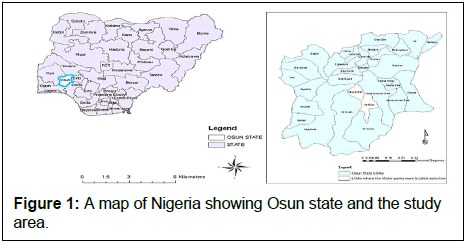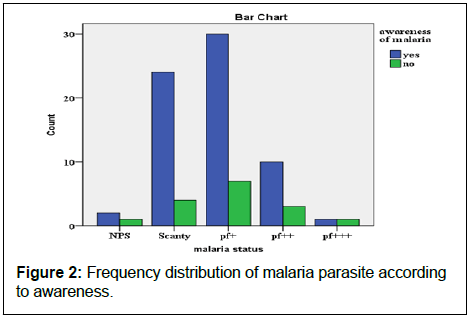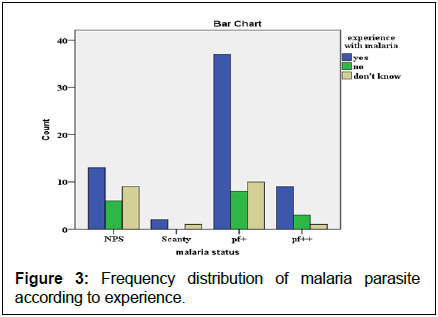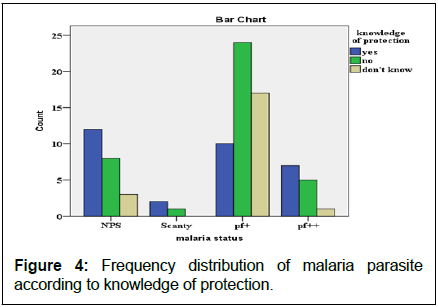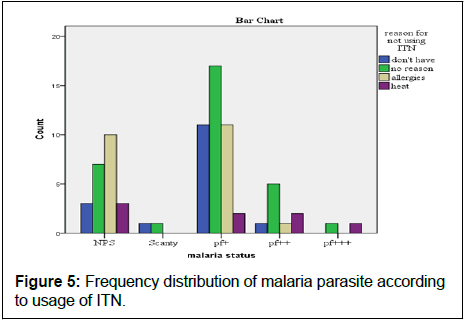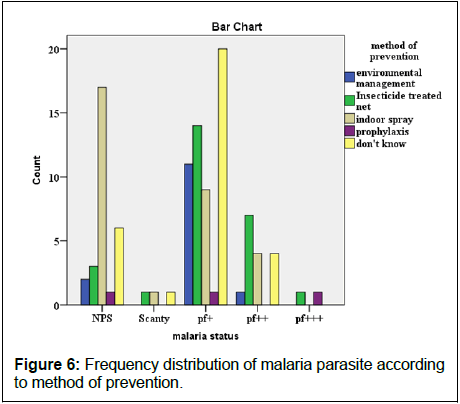Prevalence of Plasmodium falciparum among Out-Patients Attending Obafemi Awolowo Teaching Hospital Complex (Oauthc) Ile-Ife
Joseph Omololu-Aso1*, Rukayat Bolanle Fayinka1, Oluwaseun Oluwatoyin Omololu-Aso2, Oluwagbemiro Adesunloro1, Esther Oluwagbemisola Bello1, Alexander Adedolapo Oluyombo3, Eniola Abigail Oladimeji3, Blessing Florence Ajao4, Damilola Joseph Olaoye1, Eniola Akoledowo1, Akinwale Ayodeji Akinsola1, Feranmi Adebayo Ologun1, Adereti Adebobola Samuel1, Oluseun Olumuyiwa Joseph1, Olatujoye Funmi1 and Oki Matthew Oluwaseun1
1Department of Microbiology, Obafemi Awolowo University, Ile-Ife, Osun State, Nigeria
2Department of Obstetrics Gyneacology, University College Hospital, Orita-Mefa Ibadan, Oyo State, Nigeria
3Federal University of Technology, Abeokuta, Ogun State, Nigeria
4Department of Medicine, Benjamin Carson School of Medicine, Babcock University, Ogun State, Nigeria
- *Corresponding Author:
- Omololu-Aso J
Department of Microbiology,
Obafemi Awolowo University,
Ile-Ife, Osun State,
Nigeria
E-mail: omololu-aso@oauife.edu.ng
Received date: September 09, 2023, Manuscript No. IPJZDPH-23-17799; Editor assigned date: September 12, 2023, PreQC No. IPJZDPH-23-17799 (PQ); Reviewed date: September 26, 2023, QC No. IPJZDPH-23-17799; Revised date: January 17, 2024, Manuscript No. IPJZDPH-23-17799 (R); Published date: January 25, 2024, DOI: 10.36648/ IPJZDPH.8.1.001
Citation: Omololu-Aso J, Fayinka RB, Omololu-Aso OO, Adesunloro O, Bello EO, et al. (2024) Prevalence of Plasmodium falciparum among Out-Patients Attending Obafemi Awolowo Teaching Hospital Complex (Oauthc) Ile-Ife. J Zoonotic Dis Public Health Vol:8 No:1
Abstract
Malaria in humans is caused by intra-erythrocytic protozoa of the genus Plasmodium.
Malaria cases were diagnosed using blood film and rapid diagnostic tests, and also a questionnaire obtain clinical status, age, incidence of malaria, socio-cultural aspects such as knowledge and perception of the disease including symptoms, causes, severity and measures taken to prevent and control was administered to the out-patients of Obafemi Awolowo teaching hospital complex. Data from these reporting systems serve as the basis for this report.
Out of 100 patients studied 23% were Plasmodium falciparum positive, and 77% were Plasmodium falciparum negative and a result was not defined due to error malaria cases. High prevalence they notice among infants (less than 5 years old) and pregnant women who had 22.7% of all age groups tested positive and 91.3% of women tested positive respectively.
Impacts of malaria on infants and pregnant women solicit the need for the promotion of the available malaria prevention techniques.
Keywords
Plasmodium falciparum; Malaria; Antibiotic resistant; Out-patients; Antibiotics
Introduction
Malaria affects 3.3 billion people, or half of the world’s population, in 106 countries and territories [1]. WHO estimates 216 million cases of malaria occurred in 2010, 81% in the African region. WHO estimates there were 655,000 malaria deaths in 2010, 91% in the African region, and 86% were children under 5 years of age. Malaria is the 3rd leading cause of death for children under five years worldwide, after pneumonia and diarrheal disease.
Thirty countries in Sub-Saharan Africa account for 90% of global malaria deaths. Nigeria, Democratic Republic of Congo (DRC), Ethiopia, and Uganda account for nearly 50% of the global malaria deaths (WMR). Malaria is the 2nd leading cause of death from infectious diseases in Africa, after HIV/AIDS. Almost 1 out of 5 deaths of children under 5 in Africa are due to malaria [1].
The latest estimate report states that 3.2 billion people are at the risk of being infected globally while 212 million malaria cases and 428,000 deaths occurred in year 2015 [1].
Although the proportion of people exposed to malaria parasite has decreased during the last century, the absolute number of people at risk for malaria infection increased from 0.8 billion in 1900 to 3.3 billion in 2010, as a consequence of the absolute increase of the population living in malaria endemic regions.
Malaria is a major public health problem in Nigeria where it accounts for more cases and deaths than any other country in the world. Malaria is a risk for 97% of Nigeria’s population; the remaining 3% of the population live in the malaria free highlands [2]. As at 2010, 85% of Nigerians lived in areas supporting meso-endemic transmission, 15% lived under conditions of hyper-to holo-endemicity with some areas showing hypo-endemicity [3]. There are an estimated 100 million malaria cases with over 300,000 deaths per year in Nigeria, this compares with 215,000 deaths per year in Nigeria from HIV/AIDS and also contributes to an estimated 11% of maternal mortality. Of all 91 countries that have on-going transmission of malaria, Nigeria contributed 29% of total malaria cases in 2015. Malaria accounts for 60% of outpatient visits and 30% of hospitalizations among children under five years of age in Nigeria [4]. Malaria has the greatest prevalence, close to 50%, in children age 6-59 months in the South West, North Central, and North West regions. Malaria has the least prevalence, 27.6 percent, in children age 6 to 59 months in the South East region (Economic Section, United States Embassy in Nigeria, 2011) [5-7].
Most malaria deaths occur at home without confirmation of the diagnosis (Nigeria Ministry of Health (NMH), 2011). Despite all efforts at eradicating malaria in Nigeria, the sickness seems to continue to thrive in Nigeria.
In this study, we investigated the prevalence of Plasmodium falciparum among out-patients attending Obafemi Awolowo Teaching Hospital Complex (OAUTHC) Ile-Ife, Nigeria.
Materials and Methods
The study population consists of 100 among patients, who came for malaria parasite test at Obafemi Awolowo University Teaching Hospital Complex (OAUTHC) Ile-Ife, Osun state within the duration of November and December, 2018. They were selected randomly without prior knowledge of their clinical and family history.
Ile-Ife is located in Osun state. Ife is about 218 kilometers Northeast of Lagos with a population of 509,813 (BBC, 2011). It has a latitude 7°28’N and longitudes 4°30’E and 4°30’E.
The sample was collected from out-patients of Obafemi Awolowo university teaching hospital complex that came for Malaria Parasite (MP) test (Figure 1).
Sample collection
Blood samples were collected from the sampled individuals using finger-pricking method after securing informed consent from them and the hospital. Careful procedure was adopted in collection of finger-prick blood samples; the finger is swabbed with 70% alcohol and allowed to dry before collection. The collected blood samples are them tested for malaria parasite using the rapid test kit RDT.
Results
Table 1 shows the awareness of the patients to malaria and the results of their diagnosis. Out of the 100 blood samples examined using microscopy 2 (2%) of the patients aware were negative and a total of 65 (65%) were positive in various degree of measurement.
Figure 1 portrays the frequency distribution of malaria parasite according to awareness, the highest prevalence rate (pf+) was recorded in individual that are aware of the parasite.
| Malaria status *awareness of malaria cross tabulation | ||||
|---|---|---|---|---|
| Count | ||||
| Awareness of malaria | Total | |||
| Yes | No | |||
| Malaria status | NPS | 2 | 1 | 3 |
| Scanty | 24 | 4 | 28 | |
| pf+ | 30 | 7 | 37 | |
| pf++ | 10 | 3 | 13 | |
| pf+++ | 1 | 1 | 2 | |
| Total | 67 | 16 | 83 | |
Table 1: The prevalence of malaria parasite according to awareness.
Table 2 shows the prevalence of malaria infection in relation to past experience i.e., whether the patient had been previously diagnosed of malaria. Those with experience had the highest prevalence with 48 (48%) diagnosed of malaria in various microscopy diagnosis level.
Figure 2 shows the frequency distribution of malaria parasite according to past experience, the highest prevalence rate is observed in those that has past experience, at the pf+ diagnostic level.
| Malaria status * experience with malaria cross tabulation | ||||||
|---|---|---|---|---|---|---|
| Experience with malaria | Total | |||||
| Yes | No | Don't know | ||||
| Malaria status | NPS | Count | 13 | 6 | 9 | 28 |
| % within experience with malaria | 21.30% | 35.30% | 42.90% | 28.30% | ||
| Scanty | Count | 2 | 0 | 1 | 3 | |
| % within experience with malaria | 3.30% | 0.00% | 4.80% | 3.00% | ||
| pf+ | Count | 37 | 8 | 10 | 55 | |
| % within experience with malaria | 60.70% | 47.10% | 47.60% | 55.60% | ||
| pf++ | Count | 9 | 3 | 1 | 13 | |
| % within experience with malaria | 14.80% | 17.60% | 4.80% | 13.10% | ||
| Total | Count | 61 | 17 | 21 | 99 | |
| % within experience with malaria | 100.00% | 100.00% | 100.00% | 100.00% | ||
Table 2: The prevalence of malaria parasite according to experience.
Table 3 shows the prevalence of malaria parasite infection in relation to the patient's knowledge of protection, and it is observed that only 19 (61.4%) of patients with knowledge of protection were positive.
Figure 3 shows the frequency distribution of malaria parasite according to knowledge of protection, the highest prevalence level was noticed in those that lacks the knowledge of prevention of the parasite (38%).
| Malaria status *knowledge of protection cross-tabulation | ||||||
|---|---|---|---|---|---|---|
| Knowledge of protection | Total | |||||
| Yes | No | Don't know | ||||
| Malaria status | NPS | Count | 12 | 8 | 3 | 23 |
| % within knowledge of protection | 38.70% | 21.10% | 14.30% | 25.60% | ||
| Scanty | Count | 2 | 1 | 0 | 3 | |
| % within knowledge of protection | 6.50% | 2.60% | 0.00% | 3.30% | ||
| pf+ | Count | 10 | 24 | 17 | 51 | |
| % within knowledge of protection | 32.30% | 63.20% | 81.00% | 56.70% | ||
| pf++ | Count | 7 | 5 | 1 | 13 | |
| % within knowledge of protection | 22.60% | 13.20% | 4.80% | 14.40% | ||
| Total | Count | 31 | 38 | 21 | 90 | |
| % within knowledge of protection | 100.00% | 100.00% | 100.00% | 100.00% | ||
Table 3: The prevalence of malaria parasite infection in relation to the knowledge of protection.
Figure 4 shows the frequency distribution of malaria parasite infection in relation to the site of usage of insecticide treated net, 83.8% of the patients using insecticide treated net on bed were diagnosed positive.
Table 4 shows the prevalence of malaria parasite in relation to the site of usage of insecticide treated net, the highest prevalence rate was noticed in those that use it on their bed, and the rate being 27 (73%), the proposed reason for those strange occurrence is explained at chapter 5.
| Malaria status *reason for not using ITN cross tabulation | |||||||
|---|---|---|---|---|---|---|---|
| Reason for not using ITN | Total | ||||||
| Don't have | No reason | Allergies | Heat | ||||
| Malaria status | NPS | Count | 3 | 7 | 10 | 3 | 23 |
| % within reason for not using ITN | 18.80% | 22.60% | 45.50% | 37.50% | 29.90% | ||
| Scanty | Count | 1 | 1 | 0 | 0 | 2 | |
| % within reason for not using ITN | 6.20% | 3.20% | 0.00% | 0.00% | 2.60% | ||
| pf+ | Count | 11 | 17 | 11 | 2 | 41 | |
| % within reason for not using ITN | 68.80% | 54.80% | 50.00% | 25.00% | 53.20% | ||
| pf++ | Count | 1 | 5 | 1 | 2 | 9 | |
| % within reason for not using ITN | 6.20% | 16.10% | 4.50% | 25.00% | 11.70% | ||
| pf+++ | Count | 0 | 1 | 0 | 1 | 2 | |
| % within reason for not using ITN | 0.00% | 3.20% | 0.00% | 12.50% | 2.60% | ||
| Total | Count | 16 | 31 | 22 | 8 | 77 | |
| % within reason for not using ITN | 100.00% | 100.00% | 100.00% | 100.00% | 100.00% | ||
Table 4: The prevalence of malaria parasite infection in relation to the usage of insecticide treated net.
Table 5 shows the prevalence of malaria parasite infection in relation to the method of prevention and Figure 6 shows the frequency distribution of malaria parasite according to method of prevention.
| Malaria status * method of prevention cross tabulation | ||||||||
|---|---|---|---|---|---|---|---|---|
| Method of prevention | Total | |||||||
| Environmental management | Insecticide treated net | Indoor spray | Prophylaxis | Don't know | ||||
| Malaria status | NPS | Count | 2 | 3 | 17 | 1 | 6 | 29 |
| % within method of prevention | 14.30% | 11.50% | 54.80% | 33.30% | 19.40% | 27.60% | ||
| Scanty | Count | 0 | 1 | 1 | 0 | 1 | 3 | |
| % within method of prevention | 0.00% | 3.80% | 3.20% | 0.00% | 3.20% | 2.90% | ||
| pf+ | Count | 11 | 14 | 9 | 1 | 20 | 55 | |
| % within method of prevention | 78.60% | 53.80% | 29.00% | 33.30% | 64.50% | 52.40% | ||
| pf++ | Count | 1 | 7 | 4 | 0 | 4 | 16 | |
| % within method of prevention | 7.10% | 26.90% | 12.90% | 0.00% | 12.90% | 15.20% | ||
| pf+++ | Count | 0 | 1 | 0 | 1 | 0 | 2 | |
| % within method of prevention | 0.00% | 3.80% | 0.00% | 33.30% | 0.00% | 1.90% | ||
| Total | Count | 14 | 26 | 31 | 3 | 31 | 105 | |
| % within method of prevention | 100.00% | 100.00% | 100.00% | 100.00% | 100.00% | 100.00% | ||
Table 5: The prevalence of malaria parasite infection in relation to the method of prevention.
Discussion
Malaria disease is very dangerous especially the one that involves Plasmodium falciparum. An improvement in the diagnosis of malaria in endemic area at low cost will go a long way in the effort of controlling the disease.
This study was carried out using both Rapid Diagnostic test (RDT) and also microscopy. The rapid diagnostic test though not absolute, has proven quite useful in the field because of its fast nature. The rate of prevalence of 22% was recorded using the RDT.
In this study, a total of 100 patients were involved in which 65% are female and 35% are male. The study recorded a prevalence of 12.3% in female and 41.2% prevalence in male; the relatively high prevalence in male can be attributed to the major occupation in Ile-Ife, which is farming. About 60% of the male participants were farmers and some of them sleep in their farm while the wife is left at home taking care of the kids. Mosquito breeds readily in bushes and damp areas, and a farm is a typical example of that. Severe malaria is also noticed to be common among males (7%), this is due to the fact that men do not usually treat themselves or come for checkups because they are usually busy or they tend not to pay attention to the infection until it has become very serious.
A 22.7% prevalence rate was observed in patients with age ranging from 0-5 years. This is due to the weak or underdeveloped immune system found in these infants coupled with the inability of the parents to effectively protect their children against this disease.
This study observed a very high prevalence of malaria parasite in pregnant women (91.3%) among the women tested positive, this is as a result of a lot of factors, the main factor being the increased vulnerability of pregnant women to diseases due to weakened immune system that is necessary to prevent harm from coming to the baby from the mother.
The surprisingly high prevalence rate (65%) in those aware of this disease can be attributed to the nonchalant attitude of these people to the disease, some even say it is in the blood and cannot be prevented. This wrong assumption should be corrected and the right knowledge should be provided.
The relatively high prevalence rate of Plasmodium falciparum in those have experienced the disease before depicts that some do not take the complete anti-malaria dosage, after taking few; they assume they are healed of the disease and stop using the drug. This act does not only bring about the resistance of the parasite to the drug but also the infection returns when the bacteria have successfully multiplied again.
The relatively low rate of Plasmodium falciparum prevalence (21%) can be credited to the effective malaria prevention mechanisms that are employed by these people; this shows appreciable improvement in the prevention of malaria in Ile-Ife.
As observed from the study, the people that has good knowledge of the prevention of malaria has low prevalence rate (19%). This agrees with the fact that knowledge is power and I know you will all agree with me that prevention is better than cure. Through this study it has been affirmed that the best method of prevention is the use of prophylaxis due to the low prevalence rate of the parasite in those that employed this method (2%).
Conclusion
This study revealed that knowledge of malaria remains low among caregivers of children, pregnant women and mothers, majority of the mothers believed that malaria is a simple disease for which they can comfortably apply home remedies. Moreover, this study showed that some believes that malaria is not harmful. They claimed, “malaria is not so serious because everyone has it, and cannot be cured.” Some said, “It sometimes causes fever, when one takes medication the fever goes away but the malaria does not, we are born with it.” Others stated, “malaria cannot be cured, it always comes back,” and “malaria is in our blood, it is always there, just avoid going down with fever by avoiding stress and always eat good food.” A few were indifferent, and believed that mosquito bites are simply a nuisance; it is good if they can be avoided, but otherwise they have no consequences.
Nigeria is still far from completely eradicating malaria because of the little or no attention that is directed by both the government and individual into tackling the disease. This particular study reports the prevalence of malaria infection and associated risk factors among people infected with the parasite in Ile-Ife area, Nigeria.
References
- World Health Organization (2011) World malaria report, 2011. World Health Organization.
- World Health Organization (2017) World malaria report 2016. World Health Organization.
- Hay SI, Guerra CA, Tatem AJ, Noor AM, Snow RW (2004) The global distribution and population at risk of malaria: Past, present, and future. The Lancet Infectious Diseases. 4:327-336.
[Crossref] [Google Scholar] [PubMed]
- U.S. Embassy and Consulate in Nigeria (2011) Economic Section. Economic and Financial Reform. U.S. Embassy.
- Federal Ministry of Health (2012) Malaria advocacy brief for policy makers. Abuja: Federal Ministry of Health.
- Federal Ministry of Health, National Malaria Control Programme, Abuja, Nigeria (2008) A road map for malaria control in Nigeria. Federal Ministry of Health.
- World Health Organization (2018) World malaria report 2017. 1-196. World Health Organization.
Open Access Journals
- Aquaculture & Veterinary Science
- Chemistry & Chemical Sciences
- Clinical Sciences
- Engineering
- General Science
- Genetics & Molecular Biology
- Health Care & Nursing
- Immunology & Microbiology
- Materials Science
- Mathematics & Physics
- Medical Sciences
- Neurology & Psychiatry
- Oncology & Cancer Science
- Pharmaceutical Sciences
